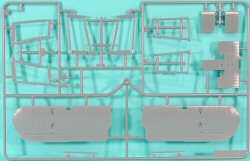
Tamiya 1/48 Swordfish Mk.II Kit First Look
By Michael Benolkin
| Date of Review | April 2007 | Manufacturer | Tamiya |
|---|---|---|---|
| Subject | Swordfish Mk.II | Scale | 1/48 |
| Kit Number | 61099 | Primary Media | Styrene |
| Pros | Still the nicest Stringbag in any scale; one of the most detailed cockpits that Tamiya has done | Cons | |
| Skill Level | Basic | MSRP (USD) | $71.95 |
First Look
 |
 |
 |
 |
 |
 |
 |
The Fairey Swordfish was designed for an early 1930s requirement for a torpedo attack and observation platform. Entering service in 1934, its large wing area enabled the Swordfish to loft an impressive amount of weight in equipment and weapons. In those days, British women had a net-like shopping bag that was easy to stow and carry to the store, but could expand significantly to bring home the groceries. This net-like bag was nicknamed a 'string bag' (for obvious reasons) and this nickname was applied to the Swordfish for its own ability to carry anything.
This biplane was obviously obsolete by the time World War II broke out, but its success in the attack on the Bismarck kept it in front-line service perhaps too long as all of the Swordfish participating in a similar attack on German battlecruisers less than a year later were lost. The Swordfish was pressed into anti-submarine warfare (ASW) duties.
Blackburn Aircraft assumed the production role for the Swordfish as Fairey was working on newer designs, and they produced the improved Mk.II version of the aircraft. The Mk.II featured the 750 horsepower Bristol Pegasus engine, a surface search radar, and metal-skinned lower wings to allow for rockets to be launched without burning the fabric wing covering. The very low take-off and landing speeds of the Swordfish allowed the aircraft to be operated off of very small decks, including converted merchant ships (though RATO was needed to get a heavily loaded Stringbag aloft on that short deck).
This is a revised version of kit number 61068, the Swordfish Mk.I that came out a number of years ago. When the Mk.I kit arrived on the market, it had set the bar significantly higher on just how detailed a kit could be straight out of the box. To top this off, Tamiya offered a separate photo-etch detail set that rendered the aircraft rigging similarly to the excellent technique used by Bill Bosworth on the Accurate Miniatures 1/48 Grumman F3F kits. I wish all biplane rigging could be done that easily!
Fast-forward to present day and Tamiya has issued the Mk.II Swordfish. This kit is molded in medium gray styrene and presented on eight parts trees, plus one tree with the clear parts.
The interior of this kit is a work of art and so are the three crew figures included in this kit. You're torn between showing off the crew in the model and showing off the interior detailing. Like the Mk.I kit, this kit offers:
- Highly detailed cockpit
- Highly detailed engine
- Separately molded rudder
- Wings can be in flight position or folded
Now being the cynic that I am, I wondered if Tamiya simply used the same sprues and changed the designator, a technique used by another Japanese hobby company. The short answer is NO. I sat down with this new Mk.II kit and my Mk.I kit and compared the two. The sprue trees in both kits are identical except for two exceptions:
- There is a new sprue tree (bottom photo, right side) containing the optional auxiliary fuel tank that sits in the middle cockpit, yagi antennas for the radar, RATO, and a few other minor details
- The existing sprue tree containing the undersides of the lower wings (second to the last photo) initially looks unmodified, but a closer look shows that Tamiya altered the molds to replicate the sheet metal skin applied to the section of each wing that would be exposed to the rocket motor exhausts. Aside from that modification, the sprue tree is identical to the Mk.I release
I am hoping the Tamiya Swordfish photo-etch parts are re-released for this kit (part number 61069) as this will make the job of rigging this Stringbag far easier.
Decals are provided for three examples:
- Swordfish Mk.II, LS276, 836 Sqn, E2, MAC-Ship Amastra, 1943-44
- Swordfish Mk.II, HS158, 816 Sqn, B, HMS Tracker, 1943
- Swordfish Mk.II, HS164, 810 Sqn, 2F, Tanzania, 1942
This is actually the fourth Swordfish released by Tamiya, the others being the Mk.I, Mk.I Floatplane, and transparent (clear) Mk.I. The only other Swordfish on the market in this scale is the SMER kit, and while there is a vac kit in 1/32 scale and a number of 1/72 scale kits of this aircraft, the Tamiya 1/48 kit is obviously the best Swordfish available in any scale!







